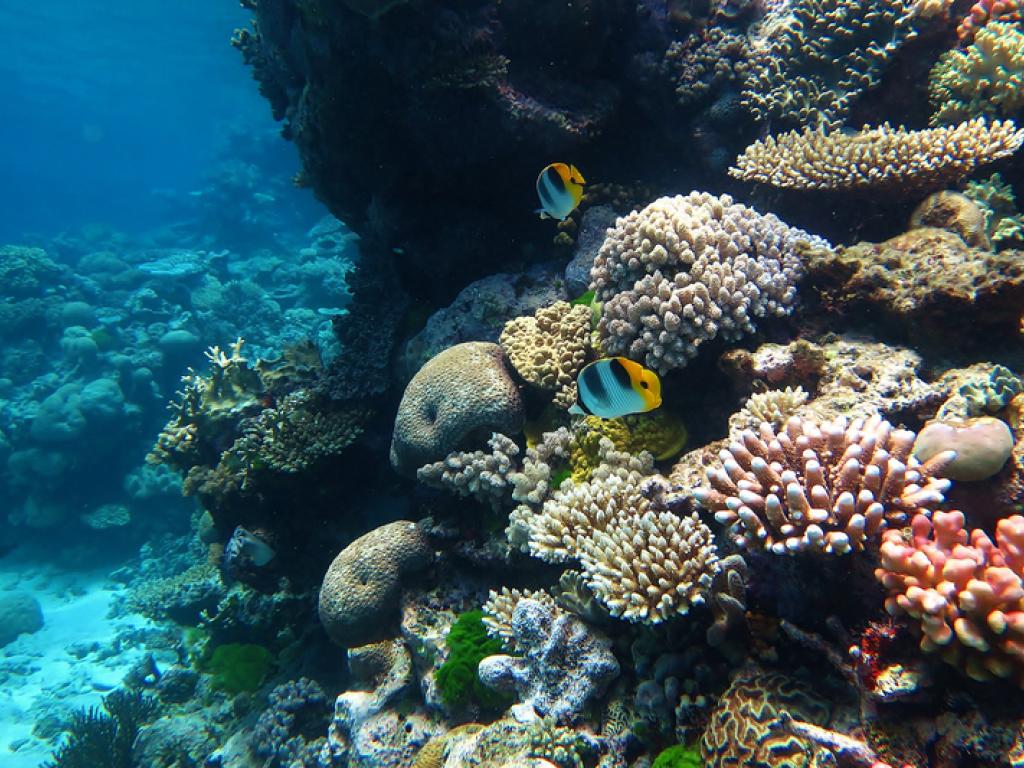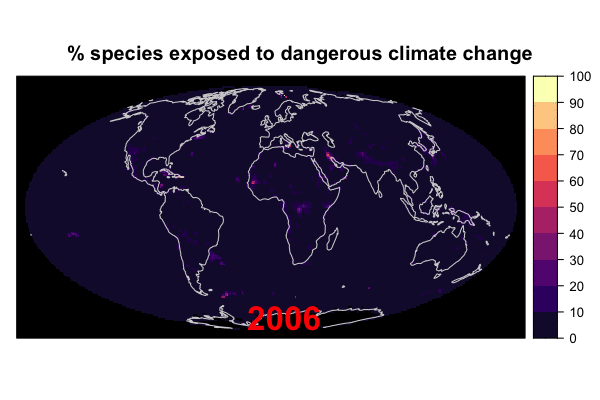Climate change could abruptly alter biodiversity


The new research shows that entire ecosystems – and not just individual species – could be at risk of abrupt ecological exposure, threatening people’s livelihoods. Recent events like the bleaching of corals on the Great Barrier Reef (pictured) suggest this is happening already. Photo Wise Hok Wai Lum, Wikimedia.
A study by a trio of researchers and published in Nature has revealed that the disruption of biodiversity from climate change on land and in the oceans will be abrupt and could be much sooner than we had expected.
The paper outlines that in many places around the world, a high percentage of species will be exposed to potentially dangerous climate conditions at about the same time, potentially leading to sudden and catastrophic die-offs of biodiversity. Under a scenario of high greenhouse gas emissions, such abrupt exposure events are forecast to begin before 2030 in tropical oceans and spread to tropical forests and some temperate regions by the 2050s.
“The main finding that surprised us was how much biodiversity is at risk in the first half of this century,” said Dr Christopher Trisos, senior researcher at the African Climate & Development Initiative at the University of Cape Town (UCT). “The risk doesn’t accumulate gradually, but can go from low risk to high risk within a decade. This abruptness of risk was really a shocking finding for us.
“It’s not a slippery slope, but a series of cliff edges, hitting different places at different times.”

The near-term risk of abrupt biodiversity collapse from climate change. Image supplied.
Trisos and his co-authors from the University of Connecticut and University College London (UCL) used annual projections of temperature and precipitation – rain, snow, sleet, etc. – across the ranges of more than 30 000 marine and terrestrial species from 1850 to 2100. They did this to estimate the timing of their exposure to potentially dangerous climate conditions.
The research shows that if we can keep global warming to below 2 °C, we can expect less than 2% of ecological communities globally to experience abrupt exposure. But the risk accelerates with the magnitude of warming, and it is similar for species in protected and unprotected areas.
“Basically, the message is that the lower the global average temperature, the fewer species are exposed and the lower the risk of an abrupt biodiversity collapse in any given place,” said Trisos.
Entire ecosystems under threat
Trisos said the research showed that entire ecosystems – and not just individual species – could be under threat, putting people’s livelihoods at risk.
He said many forecasts of risk to biodiversity from climate change have focused on the end of the 21st century. “What’s really novel about this study is that it has looked at this increase in exposure to dangerous climate change throughout the 21st century and not just a snapshot at the end.”
The team looked at almost all the animal biodiversity at a site: amphibians, mammals, birds and reptiles on land, and corals, seagrass, fish and marine mammals at sea.
Trisos explained that first they assessed information about the geographic ranges of the species. For this, they benefitted from over a century of biodiversity inventory work, in which thousands of researchers and citizen scientists have recorded where species occur over the decades.
They then added information from climate simulations from 1850 to 2005 before looking at projections from 2005 to the end of the century.
“The next step was to say: What is the warmest temperature within a species’ geographic range that we have observed in the historical climate? When you go from inside the historically experienced climate range to warmer than has ever been recorded, that’s potentially dangerous.
“It’s not a slippery slope, but a series of cliff edges, hitting different places at different times.”
“When that happens, at best, we have a massive increase in uncertainty about whether species can survive, and at worst, we have local extinction. It could be a threshold for catastrophic local extinction and that’s really scary,” Trisos said.
“We have evidence from other studies that it’s a credible risk, and we’ve already seen it in places like the Barrier Reef where coral has been dying off.”
Threat to livelihoods in Africa
Within Africa, the research reveals that extreme biodiversity loss could be seen earliest in the Sahel region, the Congolese rainforests and the tropical Indian and Atlantic oceans potentially as early as the 2040s in an extreme warming scenario.
“So many people on the coasts of Africa depend on ecosystems for vital nutrition. They fish on coral reefs. They depend on eco-tourism. We rely on healthy forests for water filtration,” said Trisos.
“If you have a sudden collapse of an ecosystem, in a decade you could lose most or all of your services. Your income is at risk. Your food security is at risk. Your mental and spiritual well-being could be at risk if those places are important for you culturally.”
He said reducing emissions could buy valuable time.
“We show that reducing emissions to a low-emissions pathway can avoid this transition to dangerous climates for many thousands of species.”
Wake-up call for policymakers
Trisos hopes that the research will be a serious wake-up call for policymakers and other key players.
“I’m hoping that showing how terrifyingly widespread and close in time this could be for biodiversity globally will lead us towards some tipping points in our response to divest from fossil fuel and transition to renewable energy.”
“Generally, people think it’s going to be bad in 2100, but this study showed it could be bad as soon as 2040.”
“Keeping global warming below 2 °C effectively ‘flattens the curve’ of how this risk to biodiversity will accumulate over the century,” said co-author Dr Alex Pigot from UCL, “providing more time for species and ecosystems to adapt to the changing climate.”
Trisos said some species may be able to adapt, but for others, it could lead to a catastrophic extinction of local biodiversity.
“If we continue on our high emissions pathway, then absolutely, abrupt collapses might happen much earlier than we thought,” Trisos concluded. “Generally, people think it’s going to be bad in 2100, but this study showed it could be bad as soon as 2040.”
What about South Africa?
In South Africa, there are several places at particular risk of abrupt disruption to biodiversity in a high-emissions scenario. These are the coast from Cape Agulhas to Mozambique, as well as inland areas on the western side of the Western Cape province up to the Namibian border, the entire Northern Cape province and parts of the Free State. In these areas, biodiversity disruption could happen more abruptly and affect more species, according to the research.
A low-emissions scenario that keeps global warming below 2 °C avoids these outcomes, with no abrupt exposure events projected for South Africa. However, the researchers did not investigate the risks for South Africa’s rich plant biodiversity.
Trisos is working on a project with South Africa National Parks to identify the areas in South Africa that are most at risk for biodiversity disruption and to help prioritise conservation responses to this. The project aims to identify the species in South Africa that will be exposed to dangerous climate change earlier rather than later this century. This can inform people managing national parks or designing new protected areas about the species most at risk now as well as where future refugia from climate change might be located. This research will also take plant species in account.
- Trisos C et al. (2020) The projected timing of abrupt ecological disruption from climate change. Nature. DOI: 10.1038/s41586-020-2189-9
Explore an interactive map of the research results.
Story: Kim Cloete